On Saturday. July 30th, three SparkFun employees arose from sweet slumber to meet at the shocking hour of 7:00 am (on a Saturday!) to travel to Pueblo, CO for the day. What could motivate such madness you ask? Why, rockets of course!
And not just any rockets, but a combined effort of Ball Aerospace, United Launch Alliance and over 100 Colorado High School Students and Interns launching a plethora of amazing incendiary aviation devices into a warm summer sky. An annual event, Ball Aerospace and ULA are encouraging students with a wide array of backgrounds to participate in creating rockets and payloads for launching. Among other efforts, Ball Interns created payloads that were loaded on “The Future”, a 25-foot tall, 300 pound high-power rocket, the largest rocket ever to be launched in Colorado.
The Future reached 10,000 feet of altitude. Among the many payloads "The Future" carried was one impressive payload designed to simulate the Mars Rover payload that contained many SparkFun parts. SparkFun employees were able to meet the Ball Intern teams that created four of the payloads at an event beforehand. The Mars Rover simulation payload integrated an Arduino/GPS/XBee onto a remote control car. The car was controlled with 900MHz and an Xbox 360 controller with a range of ~3 miles.
The Arduino module sent real time GPS to the base station as well as receiving real-time commands for driving the car. The car also had a 2.4GHz camera mounted to the front of it so they could tele-op it back to their base station. The 2.4GHz camera did not have enough transmitting range so one of the interns built a home-made receiver out of an old Direct-TV satellite dish.
Some of the other payloads created by Ball interns included an inflatable moose head with various sensors, some aliens in Ball canning jars along with a small helicopter, and a house with balloons and a live action camera to catch the footage.
The Mars Rove simulation payload also featured a miniature rocket that launched from inside the payload just after apogee. Other sensors packed into that particular payload included an altimeter and a temperature sensor.
Unfortunately, due to a mis-packed parachute, the Mars Rover Simulation payload did not deploy and the meticulously crafted vehicle plummeted to earth. Crunch. Luckily SparkFun got to witness the fully functioning payload before its demise. Rapid prototyping, while fun, is often filled with heart-breaking scenarios such as this. To the team’s credit they accepted this turn of events gamely and will undoubtedly move on to bigger and better endeavors.
We at SparkFun applaud Ball and ULA’s initiative to encourage students and interns to take a break from their regular jobs to create these amazing projects. They all obviously learned a lot and had fun in the process.
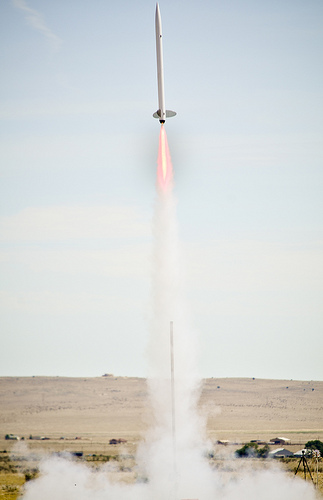
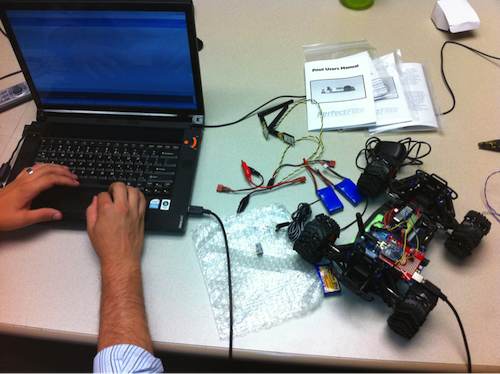
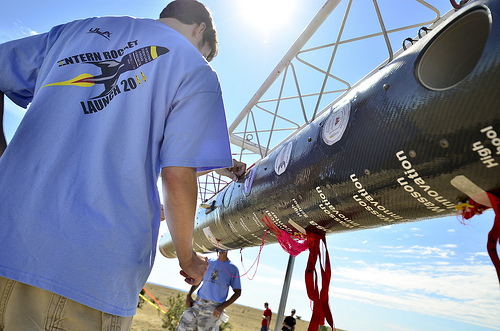
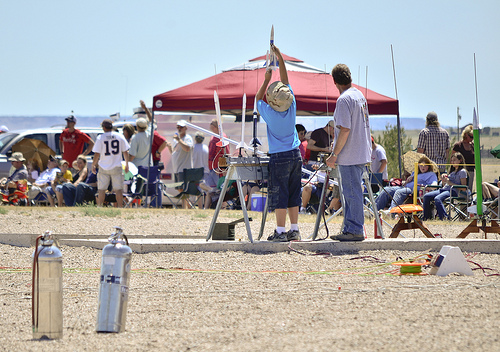
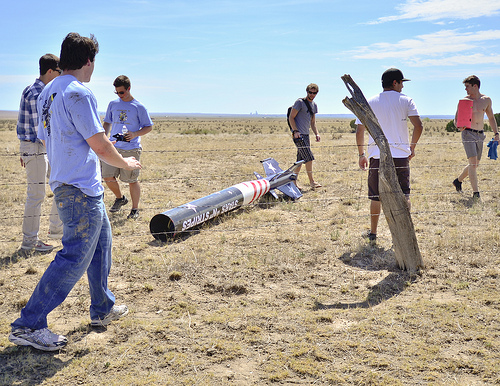






Here's a (rather shaky) video of The Future lifting off from the pad.
Wait a minute! You launched from Colorado and reached 10,000 feet? I expected to see it basically fall over and call it good. How did it do AGL?
10,000 ft AGL
I wished I would have gone! Next time, next time...
"Unfortunately, due to a mis-packed parachute, the Mars Rover Simulation payload did not deploy and the meticulously crafted vehicle plummeted to earth. Crunch. "
Why is Mars such a jinxed destination? More spacecraft have gone missing going to Mars than other planets further away. Even SIMULATED Mars missions seem to be jinxed!
It's because they're all sabotaged by the Martians.
So do they know why it was miss-packed? They weren't using ball Jars? (I know bad joke).
But there is a funny story about of Ball Aerospace- and YES they are/where part of the same company that made your canning jars that your grandmother used to uses. From the way I used to hear it: Ball Canning made too much money back in the early 80’s and NASA wanted to get rid of part of it’s satellite divisions, so Ball Canning bought that division out. And the rest is history according to one of it’s old employees. Cool fun fact is they used to make lenses out of soap bubbles (at least that's how the story goes).
Somewhere in the late '70s, a group of aerospace specialists came up with the "Great Galactic Ghoul", said to reside near the orbit of Mars.
Shouldn't the Mars Rover simulation have a 20 minute delay built in to all commands and all returned video?
It's a good question, scharkalvin. IMO, it's a move away from sound system engineering practices. During Apollo, NASA was the master of system engineering. Now, it's more of a bureaucracy than anything else. I mean, really, losing a package due to using different engineering units across an interface (Mars Explorer)?
Yeah, that "I thought you meant Newtons" thing was pretty embarrassing. That was at the height of the "better, cheaper, faster" nonsense. Unfortunately, you can have only two of them at once.
I've long thought that NASA never really recovered from the end of the Apollo program.
It is 'jinxed' because it is far away.
I don't think the problem is getting to Mars as much as getting it to stop on the surface without going crunch. As you can see, getting stuff to land safely on our planet is hard enough. If smacking into a planet counts as a successful landing, the Russians beat us to the moon by many years. I really think when those soccer ball style NASA landing crafts hit Mars, the Martians kick the mess out of it a couple of times before it comes to stop.
You mean the failures has nothing to do with the G's they are pulling to escape earth gravity? Plus the extra G's you have to pull to get a craft to escape orbit to launch it toward the plannets?
More spacecraft are sent to Mars than any of those planets, which translates to more failures.
Amazing that a company known for aluminum cans and glass jars also makes rockets and satellites. Makes me wonder when Sparkfun is going to start manufacturing wicker furniture and garden gnomes!
Ball Aerospace- That's just down the street from you guys right?
Here's video of what happens to our probes that go to Mars:
http://www.youtube.com/watch?v=yjiGH9QNiU0
(Animation by a friend of mine.)
Missions to mars fail often because originally we come from mars but it became wasted so we landed in the north of Africa in a similar climate and gradually spred out over the planet.
Now the Martians that remained don't remember us and consider us earthians and alien to them and don't trust our motives . Just as well hey?
Where can i find a similar wireless transmitter receiver which
can provide a decent range at least a 100~150 feet.Do we have something like this here on Sparkfun.
Interpret the joystick buttons as keyboard presses (check out GlovePIE) and then send those characters over serial (via XBee). The Arduino only has to interpret the ASCII characters.
I know this methog , i thought there might be some method to directly interface the xbox 360 joystick with the arduino.
Google FPV or first person video. This is the art of flying radio controlled aircraft by using a camera mounted to the aircraft and watching the live video relayed back. Most of this stuff is 2.4Ghz, and also includes speed and altimeter overlays.
Wow this is awesome.
Google Earth Live FPV & Cellular Telemetry
http://diydrones.com/profiles/blogs/google-earth-live-fpv-amp
I use LabVIEW to interface the Xbox Controller and the Arduino together in October I am coming out with a book that describes this process in detail the book is called "Practical Arduino Engineering"
LabView looks complex but will see what it can do.
Best wishes for your book.
As an aerospace engineer, I am pleased to see this and thanks, Sparkfun, for supporting this worthy program. For those interested in pursuing rocketry, I suggest you look at another Colorado business, Apogee Rockets, at www.apogeerockets.com.
(I am not associated with Apogee except as a satisfied customer)
An inflatable moose head??
I hope it looked like Bullwinkle.
Yes, an inflatable moose head. I wish we had been able to take pictures at Ball Aerospace HQ before the launch, but there was a strict no-photography policy :(
The moose head was attached to a compressed air can that was rigged to inflate upon ejection from the rocket. We never did see the outcome...
An inflatable moose head??
The camera used was 2.4 GHz but xBee was 900MHz?
The commands were sent via the 900MHz and the video feed was at 2.4GHz.
Hopefully that clears up your confusion.